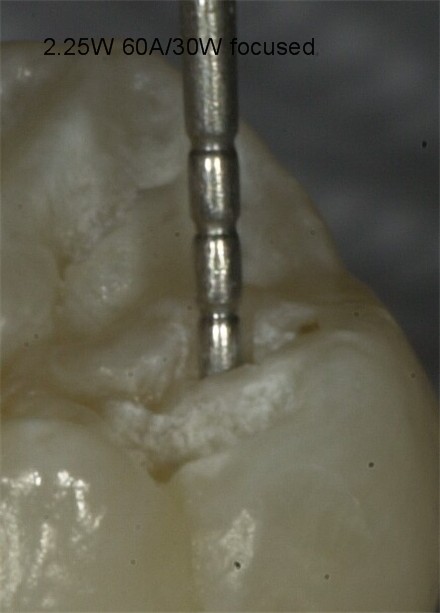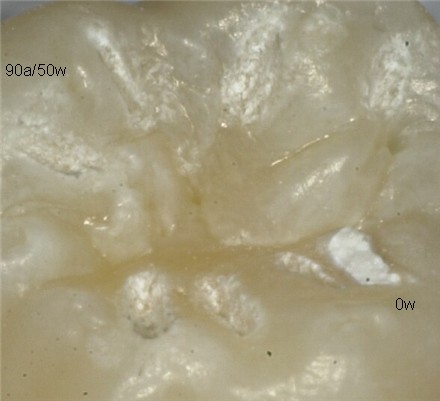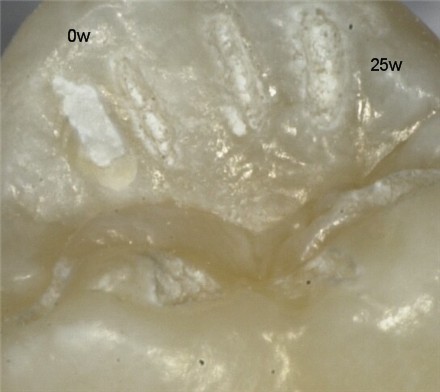Forums › Erbium Lasers › General Erbium Discussion › Rethinking Waterlase enamel settings.
- This topic is empty.
-
AuthorPosts
-
dkimmelSpectatorI usually do Marks deal with higher 5,5 W 90a/60w for 90 sec to prenumb then move in defoucsed and start to remove enamel. Then drop down to 2- 2.5 as I get in to dentin. During lunch with Kim Kutsh(sp) he talked about using much lower settings for enamel reduction.
I just could not see doing it . It would take forever.
Boy was I wrong. I have been doing 1.5W to 2.5W 50a/20w or 60a/30w. Usually it is more like 1.5W and 2W. I am also at about 1mm from the tooth . It is fast. Maybe in some cases faster and by far easier with less water spray. Anyone else using the lower settings?
DAvid
Glenn van AsSpectatorI will say this David that it will cut slower period at a lower energy setting but I repeatedly now have heard from people who have used both Delight and Biolase units tell me that particularly on the maxillary arch the Waterlase has a tremendous amount of water coming out which obscures the view. The water spray makes it more difficult to accurately see how far you are awy from the tooth and that may slow you down.
Now my question is, if HK exists then how can you cut faster with a reduced water and air spray.
Just asking a question??
GRIN
Glenn
dkimmelSpectatorGlenn 20-30% water is still a bunch of water. I really have no clue as to what is going on. I am sure others know far more. I have seen that too much water slows cutting as others have mentioned. It would make sense that there would be a optimal ratio of Watts to water for the most efficient cutting. As long as you stayed within this ratio your cutting efficiency would be the same with either high or low watts. To a point of course.
In general at the higher watts at least I tend to be defoused and with the low watts focused. It would be easy to assume the energy delivered to the site would be close to the same.
Then again I am just learning!
DAvid
Glenn van AsSpectatorDavid: I was just giving you a bad time.
In general the highest degree of cutting that I have with the laser is at the highest energy settings. I dont vary the water or air as much as some who own the biolase. We just try to get a nice water spray that still allows visibility when cutting hard tissue but isnt so little that charring or pain occurs.
I am not sure in the grand scheme of things how much the water /air% has on the whole thing.
I havent read anything in the literature that shows that there is an optimum spray. I think visibility is enhanced by certain lower settings and less water buildup etc…….
For me the waters function is to rehydrate and keep the pulp cool, so as long as there is enough water to do that then I try not to change it.
For soft tissue that is a different story. In addition if I had the ability to alter the % of air and water like Biolase users do then maybe I would feel differently.
Anyways David , from what I have seen you have learned an awful lot!!
Take care and continued success.
Glenn
dkimmelSpectatorGlenn, I am not going to give you the pleasure of saying what instrument I wish I had today!

Here is an extracted tooth.
Each cut was for 20sec. on the same extracted tooth that had been kept hydrated.
1. 5.5W 90a/60w focused at about 1-2mm
2. 2.5W 60a/30w focused at 1-2mm
3. 5.5W 90a/60w defoused at 5-10mm
It was pretty much what I had expected. The focused at the higher watts cut about 1mm. 2.5 watts was 0.5 mm and the higher watts defoused was the least at 0.25mm(guess). It may not be as obvious but the 5.5 W defoused even though it was not as deep as the 2.25W it was wider. Again as expected in a defocused mode.
So what does this mean? At 5.5W focused I fell like I am coming in too hot and too fast. Leading to a greater chance of sensitivity. Defoused at the higer Watts and working my way in seems slower the the 2.25W. Couple that with the advantage of less water spray, I like using the lower wattage settings. At least for now! I plan on trying this with now changing the water% and keeping the Watts constant. Have to workout some technical problems in taking measurements and in taking the photos. OH, it also meant I got out of mowing the yard today!!!
DAvid



(Edited” target=”_blank”>https://www.laserdentistryforum.com/attachments/upload/web5.jpg%5B/img%5D
(Edited by dkimmel at 6:33 pm on Aug. 16, 2003)
(Edited by dkimmel at 6:34 pm on Aug. 16, 2003)
(Edited by dkimmel at 6:37 pm on Aug. 16, 2003)
2thlaserSpectatorHi David,
Nice stuff, and questions. I just got back from the WCM in Vancouver, and wow, what a meeting! As for the settings, I use the 5.5W for the anesthesia, and make my INITIAL cuts in enamel using 5.5 80%air, and 50% water, not the 90/60 thing anymore. THis is an ever evolving process, and as we learn what works in our differing hands, we pass it on. Real cool. Don’t forget that the focused mode, 1.5-2mm from the tips end, IS the most concentrated energy, therefore, it SHOULD cut a bit faster. For me, I am not looking for ultimate speed, but for control of ablation, not too fast, not too slow, but just right. Everyone’s eyes, hand/wrist motions are a bit different, and so not every setting is a “cookie cutter” approach, which you have proved with your photos. Excellent conversation here, and keep sharing. I will try what you and Kim have shown, and see how it works in my hands. Should be interesting.Mark
AnonymousGuestFWIW, I’ll second the 60/30 on the air water. Tried it all week after hearing Kim at the same lunch David was at. Seems like, in my hands, things cut better and more efficiently, especially if we do not use high speed suction at all. With those settings and 2.5-3W (using the slow speed suctionstraw located at the opposite side of the mouth) I’ve been much more efficient doing class I’s.
I think with the higher water settings I was getting too much pooling in the prep or the high speed suction was actually keeping water from getting into the prep and thus less cutting efficiency.
Glenn van AsSpectatorGreat thread here guys.
How much of the slower cutting do you think is due to the fact that with the increased water and air it is more difficult to see exactly how far away you are from the tooth. I still think that the magnification is as important.
The water spray should not be flooding the prep and having not seen what the 90/60 gives you it may be that the lower air and water combo gives you both less pooling, and allows for better vision.
I like your pics David, very very well done.
Now in all honesty if HK was a big deal wouldnt the higher water and air levels make it easier to cut??
Again David, awesome pics and I know that was alot of work to do that and the pics are really nice.
You know the defocussed one sure gives you a nice bevel though doesnt it. That is why I like to use caries settings or 2watts or so for enamel bevels in class 4s to decrease the depth of each ablative cut into the tooth. It makes it easier to get bond into each and also in my hands makes it easier to hide the white etched enamel if you use lower settings to bevel.
Cool stuff David……thanks again.
It was too bad that Mark and I didnt get a chance to touch base but perhaps next time. Our schedules just didnt match but we did have a nice conversation on the phone.
Cheers to all and cya in 1-2 weeks.
Glenn
dkimmelSpectatorMore playing. This time I did
1. 5.5W 90a/50w
2. 2.5W 65a/55w
3. 2.5W 65a/45w
4. 2.5W 65a/35w
5. 2.5W 65a/25w
6. 2.5W 65a /15W
7. 2.5W 65a/7w
8. 2.5W 65a/0w
I really have no way of measuring the differences in depths. Clinically it would make no difference except for the zero water setting. As I look at the photos there are slight differences in the cuts . They are all minor and may well be more due to how the tip was postioned then the water setting.
David



(Edited by dkimmel at 7:23 pm on Aug. 17, 2003)
2thlaserSpectatorGlenn,
It was really too bad we couldn’t connect, but family comes first! Happy Birthday to your wife! Hope the party was a smash.As far as the HK thing, I think that the proper “mixture” of water, air, and laser energy are the important factors in how the erbiums ablate. If one has too much water, it seems to overshadow what the laser engergy is intended to do. In addition, I also think that if we were able to make our machines cut at a higher wattage, maybe, just maybe our ablation would be greater with more water?? just thinking out loud. Hard to say if HK is real, BUT, without the water, no real “fine” cutting exists. Just “melting” of the targe tissue. Interesting though. Nice again David. David, I suggest you talk to Ioana, or Dimitri at Biolase, and email the pictures to them…they might be able to explain or help you a bit more. Again, just thinking out loud.
Mark
P.S. The World Congress of Microdentistry Meeting was the most incredible meeting I have attended yet this year, and as you all know I have been to quite a few. Holy mackerel, the things I saw, and learned are unbelieveable. Hope you all might consider attending next year in San Fransisco!
vinceSpectatorHOLY WATER BATMAN…
Any suggestions on how to handle efficiently the pooling of water that occurs in slot and tunnel preps which muffles the lasers ablation rate?
Merci.
Vince
SwpmnSpectatorVince:
On the DELight, I just turn the water down as low as possible to prevent pooling but high enough to irrigate the lesion. With the Waterlase, I use an 11% H20 setting.
Al
PatricioSpectatorI agree with Al in that I dial down the settings to get the best visualization and cutting at a reasonable efficiency. I also turn quickly to the round bur if efficiency and visualization are significantly compromised. I often dial down to 1.5W 11/7 and add h2o if I am getting any charing.
Pat
vinceSpectatorThanks gentlemen.
Graeme MilicichSpectatorHi guys
Been asleep on this forum for some time. I see I am a month late on this string:-)))Dave,
I cut most of my slot preps at 2.5W 70%A 30%W.
If you want to dink around with lower wattage for cutting, the primary goal is to get the beam into the SIDES of prisms, not the ends of them.Cut the top off a tooth and try cutting the exposed enamel so you are cutting the sides of the prisms and see how fast 2.5W cuts!!
When preparing a slot prep, I come into it, not from the occlusal, but angle into the marginal ridge from an oblique angle so you get at the prisms lying on their sides. Opening up is way quicker and you don’t need all that horsepower.
Cheers
Graeme -
AuthorPosts
